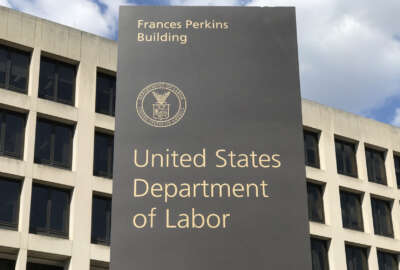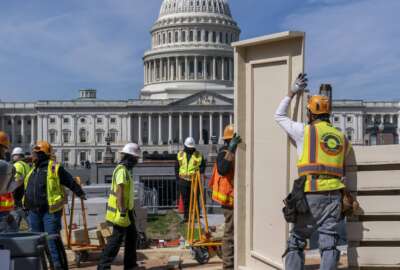Hubbard Radio Washington DC, LLC. All rights reserved. This website is not intended for users located within the European Economic Area.
Federal construction contractors have a slew of new compliance headaches
The industry is trying to understand the extent of new Davis-Bacon regulations for federal construction coming out of the Labor Department. The final rule hasn'...
The industry is trying to understand the extent of new Davis-Bacon regulations for federal construction coming out of the Labor Department. The final rule hasn’t quite taken effect, but already contractors to the government — or on federally-funded projects — have a slew of new risk and compliance obligations. For more, Federal Drive host Tom Temin spoke with Haynes Boone procurement attorney Dan Ramish.
Interview transcript:
Tom Temin And so somebody is paying you by the hour, I hope. Like they’re paying construction workers to read this £800 rule. What what’s your takeaway from it?
Dan Ramish Rightly, I think a lot of the emphasis has been on the changes in methodology for how DOL calculates prevailing wages. But there are a lot of other effects on contractors that will affect how they comply with Davis-Bacon and the Davis-Bacon related acts, which apply to federal assistance agreements, because there are various statutes that incorporate Davis-Bacon requirements. And so those requirements will extend to Infrastructure Investment and Jobs Act funded construction projects in addition to procurement contracts. But there are really five things that kind of stuck out at me, and that this is not an exhaustive list of changes, but the ways in which the regulations expand the scope of coverage of Davis-Bacon requirements. They have new rules for incorporating updated wage determinations in existing contracts. And then there are provisions about incorporating the requirements of Davis-Bacon by operation of law, if a clause or the wage rate is not included in the contract itself.
Tom Temin I mean, basically it’s a way of getting contracts to use union wage rates. If you just scrape away all of the nice language around it, this is what they want.
Dan Ramish There are effectively minimum wages for different classes of workers based on the types of construction and locality. And the administration’s aim clearly is to increase wages for construction workers on federally funded projects. And so in part, they’re doing that by expanding the scope to cover new types of work. So they specifically list various types of energy, infrastructure and related activities as types of construction. So solar panels, wind turbines, broadband installation and installation of electric car chargers are added to the list of construction, because, of course, there’s a lot of energy work in the Infrastructure Investment Jobs Act. There’s also an expansion of the definition of the site of the work. The traditional rules do have some coverage of off site work, but it’s somewhat limited. Generally, it’s limited to the physical location where the construction will remain. But there’s broader coverage in the new role for secondary construction sites, which the Department of Labor indicated that it’s intended to respond to technological developments that allow companies to do more construction of entire portions of public buildings offsite and then transported to the site just to install it. And so the new regulations will provide for coverage of secondary construction sites where construction is for specific use in the building or work, and it’s not simply reflecting a manufacture construction of a product made available to the general public.
Tom Temin Right. So this could be then the fabrication of, say, steel trusses. And instead of fabricate or instead of putting all the pieces together like a puzzle at a site, it might be assembled somewhere else, put on a flatbed and then the roof trusses of steel or something, I’m just making this up, would be delivered, but that would be covered. The construction of those trusses.
Dan Ramish It gets to be a little bit of a finer point, because commercial fabrication plants with prefabricated housing components are not covered. The rules are pretty complicated, but it’s got to be a larger portion of the building and not just a prefabricated housing component.
Tom Temin I’m just trying to imagine what piece of a building that say, five stories tall that you can make somewhere else and bring to the site. But regardless, that’s what the rules say. We’ll have to leave the constructors to for those details.
Dan Ramish Yes. And so there is broader coverage where parts of the construction are constructed offsite at locations that are dedicated exclusively or nearly so to the performance of the contractor project, under the old rules or the current rules, until the new rules go into effect, only offsite locations that are established specifically for the performance of the contractor or that are directly adjacent to the site of the work are covered by Davis-Bacon. So there are probably new contractors and new portions of the work that contractors are performing that will be considered Davis-Bacon construction now under the new rules.
Tom Temin We’re speaking with Dan Ramish. He’s a partner at Haynes Boone. And you used the word buy operation of law. What does that mean in a regulation?
Dan Ramish Many people who are involved in federal government contracts are familiar with the Christian doctrine, which is a doctrine that developed in the case law that recognizes that where there’s a mandatory requirement to include a contract clause in a contract, and that expresses a significant or deeply ingrained strand of public procurement policy. That clause will be read into the contract, even if it’s left out by accident, because the contracting officer doesn’t have authority to leave it out. The regulations now for Davis-Bacon will provide for incorporation of the Davis-Bacon requirements, even if the clause is or the prevailing wage schedule isn’t included in the contract. But contractors don’t need to be too worried insofar as it also provides that contractors must be compensated for resulting increases in wages in accordance with applicable law. It does mean that there can be administrative hassles of having to make back payments, but they’ll get paid at the end of the day.
Tom Temin So in other words, the taxpayers are paying these higher wages for federal construction, basically, which I guess was always the case.
Dan Ramish That’s right. And certainly industry groups have been quick to say the taxpayers are the ones that are ultimately paying for wages for construction workers on federally funded projects.
Tom Temin Got it. All right. And then what about noncompliance? You’ve found that there are some provisions for consequences of noncompliance with all of these provisions.
Dan Ramish That’s right. So the rules were somewhat more relaxed or less severe for violations of the Davis-Bacon related acts than for Davis-Bacon violations. So the rules that apply to a federal federally assisted contracts like grants and so forth, didn’t provide for as harsh penalties in some cases. So the debarment standard, for example, under Davis-Bacon provided for a mandatory three year debarment period. And whereas, under Davis-Bacon related acts, there was a maximum three year period. And there’s broader coverage of debarment of entities in which the debarred entity has an interest and responsible offers. And so the Department of Labor is bringing the rules for Davis-Bacon related acts applicable to grants, cooperative agreements, loans and loan guarantees and so forth, into alignment the procurement contract consequences, which are pretty severe. And so where the the standards had been lower, relaxed, they’re now as strict as as for Davis-Bacon, and that applies also to the debarment standard itself. There was a slightly lower standard requiring aggravated or willful violations rather than just disregard of obligations to workers or subcontractors.
Tom Temin All right. Sounds complicated and expensive for the compliance regime that you’re going to have to have, I guess, as a contractor. And whistleblower protections are also cited in this rule.
Dan Ramish Yes. Along the same lines, there previously were not any explicit protections for whistleblowers. And by way of encouraging whistleblowers to step forward, now, there are provisions protecting people that report violations or issue complaints or otherwise cooperate with investigations or compliance actions or testify protecting them from retaliation by their employer.
Tom Temin All right. So if you add all of this up, then, what should federal constructors, construction contractors do now?
Dan Ramish Well, there are a lot of complicated rules surrounding which specific workers and types of workers and work are covered by the Davis-Bacon requirements. And the consequences for not paying the prevailing wages in accordance with the requirements are pretty severe. So contractors need to look carefully at the extent to which the Davis-Bacon coverage is changed under the new rules and be careful to comply in projects moving forward once these rules go into effect.
Tom Temin Right. This rule is not totally in effect yet, but it’s basically signed and sealed, just not delivered.
Dan Ramish Yes, the Federal Register indicated the scheduled publication date was Aug. 23 and the rule will go into effect for most purposes 60 days after it’s actually published in the Federal Register. There are a couple of exceptions where the changes in the updating of wage terminations and existing contracts go into effect without that 60 day delay. But most existing contracts awarded before that effective date will be under the regulations that were in effect when they were awarded.
Copyright © 2024 Federal News Network. All rights reserved. This website is not intended for users located within the European Economic Area.
Tom Temin
Tom Temin is host of the Federal Drive and has been providing insight on federal technology and management issues for more than 30 years.
Follow @tteminWFED




